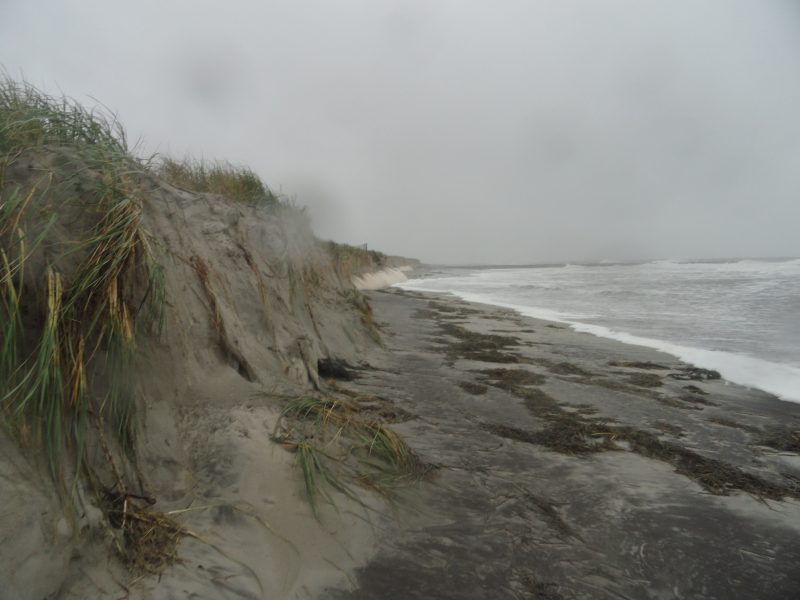A geotube at Waverly Beach along East Atlantic Boulevard, shown here in the background after it was exposed by Superstorm Sandy was credited with saving Ocean City homes. (Photo courtesy City of Ocean City)
 By MADDY VITALE
It is expected to stretch two blocks long, will look like a huge sock and will be filled with sand.
What is it?
Ocean City plans to bury another giant geotube in the dunes to protect the shoreline. Geotubes previously worked well in protecting other vulnerable spots in Ocean City’s beaches, including Waverly Beach along East Atlantic Boulevard.
Now, the city wants to put a geotube in another area suffering from erosion – between Fourth and Fifth streets.
“They basically work like a bulkhead – except bigger and stronger, and filled with sand native to the surrounding beach,” explained Ocean City Public Information Officer Doug Bergen on Wednesday.
Mayor Jay Gillian said in his Mayor’s Message on Oct. 25 that during a City Council meeting the night before, Council members approved a bond ordinance that includes potential funding for the installation of geotubes on the eroded beach in the area surrounding Fifth Street.
“I have instructed the city team to work with the Army Corps of Engineers and the state Department of Environmental Protection to see if it’s possible to use this technology there,” Gillian said in his message. “Geotubes are giant cylinders made of plastic fabric and stuffed with sand, then buried by more sand and dune grass.”
He also described how well the geotubes work under the dunes along East Atlantic Boulevard.
“They were the only thing that saved many north-end properties during Superstorm Sandy in 2012,” he said.
At the Oct. 24 City Council meeting, Chief Financial Officer Frank Donato told the Council members that the city wants to piggyback on the U.S. Army Corps of Engineers’ beach replenishment project to install a large geotube that would help protect the shoreline between the areas of Fourth and Fifth streets.
Ocean City, Sea Isle City and Strathmere are part of a $32.5 million Army Corps of Engineers beach replenishment project that will deposit a total of 2.4 million cubic yards of fresh sand along the eroded shoreline of all three towns.
The project is expected to get underway this fall and be completed in time for the 2020 summer tourism season.
By MADDY VITALE
It is expected to stretch two blocks long, will look like a huge sock and will be filled with sand.
What is it?
Ocean City plans to bury another giant geotube in the dunes to protect the shoreline. Geotubes previously worked well in protecting other vulnerable spots in Ocean City’s beaches, including Waverly Beach along East Atlantic Boulevard.
Now, the city wants to put a geotube in another area suffering from erosion – between Fourth and Fifth streets.
“They basically work like a bulkhead – except bigger and stronger, and filled with sand native to the surrounding beach,” explained Ocean City Public Information Officer Doug Bergen on Wednesday.
Mayor Jay Gillian said in his Mayor’s Message on Oct. 25 that during a City Council meeting the night before, Council members approved a bond ordinance that includes potential funding for the installation of geotubes on the eroded beach in the area surrounding Fifth Street.
“I have instructed the city team to work with the Army Corps of Engineers and the state Department of Environmental Protection to see if it’s possible to use this technology there,” Gillian said in his message. “Geotubes are giant cylinders made of plastic fabric and stuffed with sand, then buried by more sand and dune grass.”
He also described how well the geotubes work under the dunes along East Atlantic Boulevard.
“They were the only thing that saved many north-end properties during Superstorm Sandy in 2012,” he said.
At the Oct. 24 City Council meeting, Chief Financial Officer Frank Donato told the Council members that the city wants to piggyback on the U.S. Army Corps of Engineers’ beach replenishment project to install a large geotube that would help protect the shoreline between the areas of Fourth and Fifth streets.
Ocean City, Sea Isle City and Strathmere are part of a $32.5 million Army Corps of Engineers beach replenishment project that will deposit a total of 2.4 million cubic yards of fresh sand along the eroded shoreline of all three towns.
The project is expected to get underway this fall and be completed in time for the 2020 summer tourism season.

In one of the photos provided by Bergen from Oct. 30, 2012, the morning after Superstorm Sandy, it shows the Oct. 29, 2012, storm flattened the dune at Waverly Beach along East Atlantic Boulevard.
“The geotube was the only thing holding back the ocean,” Bergen pointed out. “The geotubes definitely saved a good bit of north-end property.” Since then, the shoreline there has dramatically improved. “At Waverly, the dunes and beach have grown substantially over time, and the geotubes have not been exposed since Sandy,” Bergen said. “But it’s nice to know they’re there as an insurance policy. The city would hope for the same at Fifth Street.” On Oct. 28, 2012, as Superstorm Sandy approached Ocean City, a healthy dune was beginning to erode enough to slightly expose the geotube at Waverly Beach along East Atlantic Boulevard. (Photo courtesy City of Ocean City)
On Oct. 28, 2012, as Superstorm Sandy approached Ocean City, a healthy dune was beginning to erode enough to slightly expose the geotube at Waverly Beach along East Atlantic Boulevard. (Photo courtesy City of Ocean City)